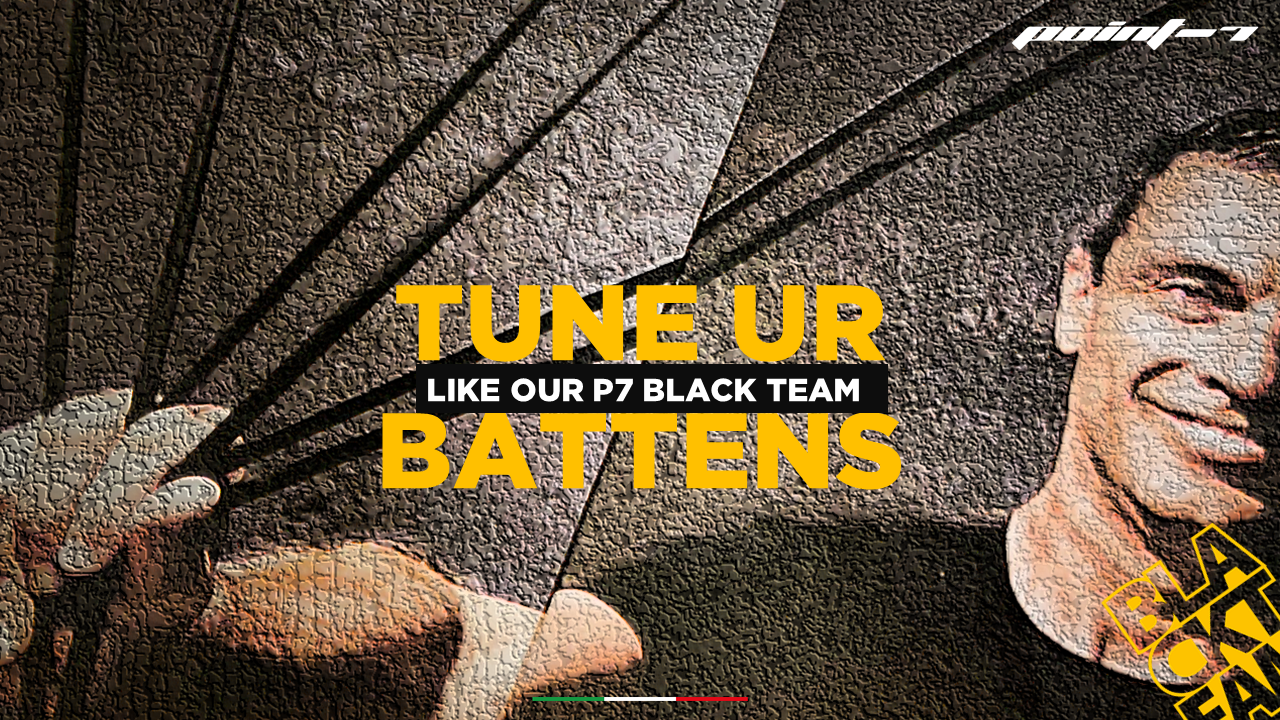Are the battens tuned from the factory? In our case we do teach our production how we would like our battens to be set, but we cannot expect that it’s done at 100% correctly. Different people working from time to time, not enough feeling in the pressure, it’s not always as we would like. You could claim that the battens are pre-tuned, but do not expect it to be at 100%. The sail will work as it is but is always better to give it a check. Is also nice to know in detail how you trim each part, and you will need to tune your battens over time, as materials stretch and if you often fall, they could with time loosen up a bit.
Battens can be tuned without rigging from an experienced sailor, and this can happen if the battens are in total integration with the sail project. You can trust that our Point-7 battens are fully in love with our Point-7 sails, so let us show you how to learn it to do it yourself as well.
To tune battens, you need to understand how a sail works and how battens work. We won’t get to too many details as it’s an endless world, that if you have done some years of PWA racing you would understand and it’s better to leave that to the pros but let us give you some general details.
Battens are very important to finalize the tuning of the sail They can:
-
optimize the performance of the sail.
-
enforce a characteristic.
-
bring an update to the performance of the sail.
The purpose of the batten is to give a skeleton to the body of the sail. Meaning that on one side the battens are there for making the structure stiffer, but on the other side, a good batten set up allows the sail to breath with them inside.
Making the structure stiffer, means that the battens help the sail to enforce a profile stability or stiffening up an area from having too much pressure, or to direct the wind to give pressure to a different place.
Breathing with the sail, means that the battens do not block the flow of the wind in some areas, they allow the sail to follow the reflex of the mast, the ‘S’ shapes of the sail, and be softer in areas where you need more depth for having more pressure.
-
Optimize the performance of the sail: The sail will work better if the battens are having the right tension. They will follow the natural concept of the sail, meaning the profile and the opening of the leach.
-
Enforce a characteristic: Some areas of the sail might need a stiffer batten to create an area from not having too much pressure, or it needs to have a softer area to have the ‘S’ shape to work better.
-
Bring an update to the performance of the sail: Some riders by testing realize that a sail could need more power or stability in some areas of the sail, and with a different batten set up they can change the feeling of the sail. Normally this can be changed by modifying the sail itself, but often it could be a personal need of more or less power, or just an upgrade that can be put in the next sail in production.
How do you tune your battens? A good sail has battens which follow the soul of the sail and enhance its qualities. Some people receive the sail and do not bother with tensioning the battens. Mast, extension, boom and out on the water. Others think that the more pressure the better. Others pull till wrinkles disappear. None of these are correct.
In simple words. The wind goes in the sail from the front and needs to exit from the back of the sail.
[/col] [/row] [row style=”collapse” padding=”0px 0px 0 0px”] [col span__sm=”12″ divider=”0″ padding=”0px 0 0px 0px” margin=”0px 0 0px 0px”] [ux_image id=”74810″ image_size=”original” lightbox=”true”]A: The sail works better when the wind exits from the back of the sail, and not from the top or bottom. This is why you also close the gap of the sail as you don’t want the wind to go out from the bottom of the sail, hence you lose power. This should give you the hint that the bottom batten and top batten of the sail need more batten tension as the wind needs to be blocked from exiting from the base and the top. Just as the base batten needs more tension, also all the battens under the boom need more tension as you want the boom to give pressure to your back hand.
Summarizing A: Battens below the boom and the top batten need more tension.
B: If we take out the top batten and the battens below the boom, we are left with only the battens in the middle, meaning: The battens over the boom, and the battens under the top batten. This is where the sail has the leach opening. Why does the leach open? The leach opens to allow the wind to exit. What happens if we put a lot of tension on the battens? The batten will push to the front of the sail, and when there is no more place to go in the front, and you keep putting pressure, the batten will arc itself. When the wind tries to exit the sail, and will find an arc shape of the batten, the wind will not be able to exit, and will push hard on that arc to try to open it. This will create a useless ‘uphill’ for the wind to exit, it will give a useless power to your back hand which we can only call extra drag. Therefore, a loss of speed and a waste of energy, as this arc will cause a breakage from having a nice progressive opening of the leach once the sail is into the wind.
[/col] [/row] [row style=”collapse” padding=”0px 0px 0 0px”] [col span__sm=”12″ divider=”0″ padding=”0px 0 0px 0px” margin=”0px 0 0px 0px”] [ux_image id=”74811″ image_size=”original” lightbox=”true”]Summarizing B: Battens over the boom and below the top batten need no tension. Just enough to keep the batten no moving from inside the batten pocket.
What do we mean giving tension for A, and no tension for B. Let’s go now step by step how you should take steps in tuning your battens.
-
Unroll the sail.
-
Put pressure on all the battens. This will make sure that all the battens are at the end touching the batten pocket end. Do not pull that you break it. Just put tension, when you feel it went all the way in, stop.
-
Release all the tension from all the battens. This is what we call a reset. The battens are all the way in the batten pocket and there is no tension on them.
-
As we said, the battens are there to enhance the soul of the sail, so now we need to tension the battens the way that they follow this soul and not kill it.
-
Let’s tension all the battens under the boom and the top batten first. We start putting tension and in the first rounds you might notice no pressure on the tensioner while turning the key. At one point, you will start feeling some tension. From that point 2 extra rounds of key are more than enough. You don’t need to give it more as it would be just be creating the material to suffer and blocking the S-Shapes built in the sails, which need to work when you get overpowered.
-
Let’s now tension the battens over the boom and all the battens below batten 1. We start turning the key and as soon as then you feel tensionpressure on the batten key, do only a turn of 90°, but not even.
-
Rig the sail.
-
Once rigging is done the sail will be at 95% tuned perfect with the battens, but you can still do more on the battens over the boom and below batten 1. Release the batten key slowly, till you almost start seeing wrinkles coming out. Stop, and give that extra 90° turn to give again the little tension needed.
-
Go on the water. If you are using a cam sail, and you feel the rotation a bit stiff, go back to the beach and take out 360° tension from the batten of the cam which feels the stiffest. This will make the cam to rotate smooth as ever.








